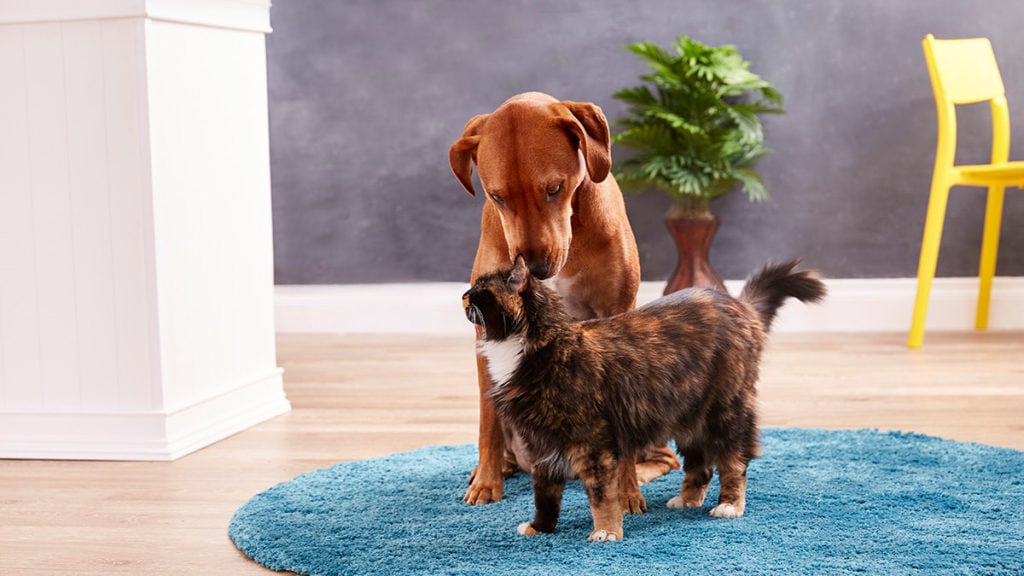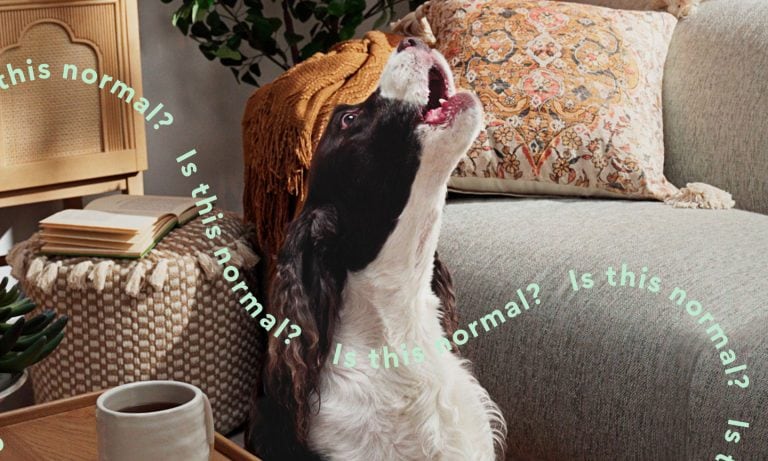If you have more than one pet, you might spend a lot of time playing referee—whether it’s settling a quarrel over treats, breaking up a fight that started as play, or figuring out how to get two dogs to like each other. If your household includes different species, it’s even more difficult to keep the peace.
When there’s unrest in your home because the cats don’t get along with their canine brother, or the dogs can’t resist chasing the bunny, is it possible for them to live under the same roof without someone getting hurt? Well, it depends. Irith Bloom, certified dog behavior consultant, CPDT-KSA, faculty at Victoria Stillwell Dog Training Academy, and director of training at The Sophisticated Dog in Los Angeles, says, “In certain cases, it simply isn’t possible to get all the pets in a household to like each other.” She explains that when pets are fighting at the slightest provocation, they might need to be separated at all times for everyone’s safety, and in extreme cases, one might actually have to be rehomed.
But don’t give up just yet on managing your multi-pet family. Bloom adds that, “In many cases, a long-term management and training plan can keep the household calm,” although she warns that it may not necessarily be friendly.
How to Get Two Dogs to Like Each Other
The first step toward a doggie truce is to consult a certified professional dog trainer, certified animal behavior consultant, certified applied animal behaviorist or veterinary behaviorist, advises Bloom. These professionals can help determine if your pups can learn to cohabitate without you having to constantly worry about their safety. They can also create a custom training program to improve their relationship, when appropriate. According to Bloom, “These kinds of training plans will involve gradual introduction (or re-introduction) of the dogs, in circumstances that teach them that life is more fun when the other dog is around.”
Dogs who haven’t had obedience training can certainly get along, but if you have two dogs that tend to fight, the lack of training makes these tense situations difficult to manage. Bloom points out that part of dog training involves impulse control, which can help dogs keep calm instead of reacting, although it can’t always prevent problems.
Are My Dogs Playing or Fighting?
Whether you have obedience trained pups or not, every pet parent should know how to tell the difference between play-fighting and actual fighting that can lead to injury. There have probably been times where you wondered, “Are my dogs playing or fighting?” Bloom helps us out with a steadfast rule: “If one of the dogs gets bitten, the dogs are fighting.” Other than this surefire distinction, it can be hard to tell, but Bloom gives us some telltale signs to look for:
- It may be fighting if one dog is struggling to get away, and the other keeps pinning the first dog down. Although it may not be technically fighting, it’s not good play. “Good” play is balanced, with regular pauses in the action for the pups to catch their breath. To resume play, both will “ask” if the other dog wants to play by doing a play bow. If you don’t see pauses or bows, and one dog is yelping or struggling to get away, it can escalate quickly into a fight, says Bloom.
- Look for certain dog body language that signals playtime at the start of the action. Bloom says these “meta-signals” tell the other dog that everything that comes after is just intended as play. The most common is the play bow, where you’ll see a dog lower their front end and keep the back end high, as if they are bowing. An abbreviated version is “play slaps,” where dogs will slap their front paws down, or bark and then run away to say, “Chase me!” If there is no meta-communication, “The dog on the receiving end of the play-growls or play-bites might assume the aggressive behavior is in earnest, so the dogs say in advance, ‘Hey, we’re just playing here.’ These meta-signals will tend to happen after every break in the action during play, too,” remarks Bloom.
To answer the question “Are my dogs playing or fighting,” you should see dogs that look relaxed, take breaks and reengage in a playful way, with regular meta-signals mixed in. If instead, the dogs look stiff, scared or anxious, and there are no breaks or play bows, it’s either already a fight, or will soon become one. Bloom cautions to never get in the middle, but to instead clap your hands, shake a jar full of change, or make some other loud noise to break up the fight.
What to Do When Cats Don’t Get Along
What about cats that aren’t quite friends? The bad news is that this is more common than with dogs, and some cats will never become friends. Bloom encourages thinking carefully before adding a second adult cat if you already have one adult cat. But if you already have two or more, and your cats don’t get along, there are a couple of options. The first is to consider rehoming one or more of the cats so each can have the space and attention they need. And the other is to separate them and go through a careful, slow introduction or re-introduction process. This method involves “teaching the cats to be comfortable with each other’s scents, to tolerate seeing and hearing each other, and to share space safely,” says Bloom. To create a training program for your specific needs, consult a certified animal behavior specialist. Be aware that this process may take weeks or even months, with no guarantees, so you should be prepared to rehome one of the cats, if necessary, for their safety and happiness.
How to Get My Cat to Like My Dog
And, of course, there are households that maintain the cat-dog rivalry, complete with growling, hissing, lunging, swatting, staring, barking, jealousy and food guarding. If you’ve ever searched, “How to get my cat to like my dog,” this advice is for you. Just like with the same-species issues, a reintroduction is in order. The other thing to do is to assess your home for kitty-safe spots. Bloom suggests adding shelves or a tall cat tree to make sure your cat can escape from the dog if they feel unsafe. And even though you feel the urge to yell at either animal for showing aggression or discomfort, this is the opposite of what pet parents should do. “When we yell at or hit an animal, we make the situation tenser and more unpleasant,” says Bloom. “What’s more, we may also be sending the unintentional message that the human also wants the other animal to go away.” This increases stress, making the relationship worse. Again, the best answer here is to consult a certified expert who can help.
Can Cats and Dogs Co-Exist With Small Pets?
It is possible to have small animals along with cats and dogs in your home, although you have to remember that you’re mixing prey animals with those that would be their natural predators in the wild. So before you open the cage and let your bunnies, ferrets and birds run loose, you have to take some precautions. “I would certainly never have small prey animals out of their cages around predator animals such as cats and dogs when they are unsupervised,” notes Bloom. “Even with supervision, I would never allow them to be loose together unless I had done a great deal of preparation and testing of all of the animals involved using safety barriers first.” An easy way to separate your pets is with a wide safety gate like the MyPet Extra Wide Wire Mesh Gate or the MyPet Windsor Extra Wide Arch Pet Gate. Even after installing dog gates you’ll need to devote 100% of your attention to supervising all animals, because as Bloom warns, all it takes is one lapse of attention for a tragedy to happen.
Ways to Reduce Stress in Multi-Pet Households
If you sense a lot of tension and anxiety coming from one or more animals in your home, certain products can help. Adaptil Electric Dog Diffuser is a plug-in diffuser that mimics the pheromone released by mother dogs to calm their litter. Feliway MultiCat Diffuser Plug-In + Refill is the feline equivalent. Bloom warns that it may take a few weeks to see results, and these pheromones are more effective with some cats and dogs than others. You should also use the diffusers alongside a training program.
To give small animals and birds a feeling of safety, place their cages in areas where other animals can’t stare in. It might be difficult because cats can jump and climb pretty high. Bloom suggests creating a haven in another room for birds and small pets. Otherwise, you will need to creatively arrange the furniture to keep them from being stalked by their siblings. They will also need forms of enrichment, such as bird perches and toys; small pet hideouts, habitat expansions and toys; and clean bedding for burrowing.
Tips for Introducing a New Pet to a Current Pet
When you’re looking to add a new furry or feathered family member, is there such a thing as the best dogs for cats, or a way to tell which will do well with small pets or birds? Although Bloom is wary of generalizing about breeds, she says there are certain dog breeds that might have more issues, including Terriers or those that were bred to hunt and kill small animals. Here are some more tips:
- Get a dog who would do well with your cat. Choose a calm, adult dog who has experience with cats. Puppies might be scary because of their playful nature, but it can work with a careful introduction.
- Get a cat who would do well with your dog. An adult, dog-savvy cat is best, or a young kitten if you know the dogs will behave appropriately. Maine Coons get along well with dogs, although each cat is different.
- Be cautious of adding a predator animal to a house with small animals. This is more about evaluating the individual animals, but there are no guarantees here. Consult a certified professional if you need help.
Hopefully these tips can help you keep the peace (or at least establish a truce) in your multi-pet home. If you aren’t sure if the animals in your home can live together safely, the best advice is to consult a certified professional dog trainer, certified animal behavior consultant or certified applied animal behaviorist.

Nikki Naser, BeChewy Senior Editor
Instead of owning 30 cats, Nikki has an impressive collection of 30 cat-themed T-shirts, and just 4 pets—a ginger-haired senior cat, a senior Maine Coon, a middle-aged Choodle, and a young kitty who showed up one day on the back steps. A former Orlando resident, Nikki worked on several tourism publications before moving to South Beach. When she’s not stopping to take pics of community cats to post on Instagram, Nikki spends her time with the office pets at Chewy, writing for their BeChewy blog.
Share:














